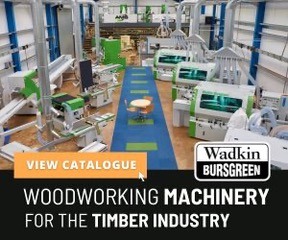ABS (acrylonitrile-butadiene-styrene) replaced PVC as an edging finishing material for chipboard over 20 years ago. This plastic material is characterised by its outstanding processing characteristics and material resistance. The edging specialist Ostermann provides information on the material and its utilisation in the furniture production.
What do a car, a Lego brick, computer housing, a ski and the mouth-piece of a clarinet have in common? Quite simply – ABS is regularly used in their manufacture. The plastic is characterised by a high mechanical abrasion- and scratch-resistance, lightfastness and heat resistance. In the furniture production industry, ABS has been used for over 20 years in the making of furniture edgings.
This flexible synthetic material enables the open cut surfaces of coated chipboard to be perfectly sealed. It is here that ABS proves to be a winning material with its easy processing, unlimited design options, homogeneous appearance up to the radius area and its resistance against chemicals and detergents.
Extremely versatile
Ostermann edgings are available in innumerable colours and decors, with different surface finishes and several widths and thicknesses. A colourless or grey solid material in its basic form, ABS can be prepared in all required plain colours or wood and fantasy decors or be homogeneously coloured. ABS edgings are also available in various shapes and thicknesses.
Depending on the requirements and the application, Ostermann supplies ABS edging in many different thicknesses and in every width up to 100mm. The surfaces can be lacquered to achieve a great variety of gloss levels – from super matt to high gloss. Because it is not only the look of the edging that is increasingly critical, but also its feel, Ostermann delivers ABS edgings with numerous different finishes, such as ash pore, minipearl, lineal structured or wood structured.
High-quality and economical at the same time
Due to its flexibility and impact resistance, ABS edgings deliver a high-grade quality finish to furniture edgings. In this respect, ABS is particularly cost-efficient compared to materials like solid wood or polypropylene (PP). This is true also for its disposal. Unlike its predecessor, PVC, which releases toxic acids and dioxins when burned, the formaldehyde-free ABS material can be incinerated with wood waste at the required temperature.
Easy processing
As an edging material, ABS edgings can be processed using all conventional edge-banding machines and technologies. For bonding, all common hotmelt adhesives can be used such as ethyl-vinyl acetate(EVA), polyurethane (PUR), polyamide (PA) and polyolefin (PO) as well as the special edging glue Kantol for manual bonding
For an optimal adhesion of the glues on the edging, the ABS edging is always applied with a special bonding agent, known as a primer. Furniture makers who do not use edgebanding machines, can look to a special service offered by Ostermann. To meet their requirements the edging specialist company delivers ABS edgings that are pre-coated with EVA hotmelt adhesive.
Paintability
Basically, ABS edging is paintable with various polyurethane and Desmodur/Desmophen (DD) lacquers. Nitrocellulose lacquers are not permitted. For painting thin surfaces, Ostermann recommends special paintable edgings from the Ostermann range. The Ostermann paintable edgings are compatible with almost all commercially obtainable paints because of its special surface. Even water-based paints adhere perfectly.
Application using the latest edging bonding processes
As with the laser and hot air technology, edgings can only be processed using Near Infrared Radiation (NIR) technology with a special functional layer. Here again, ABS edgings prove to be the perfect solution. The benefit of Ostermann’s ABS edgings is that they can be subsequently coated effortlessly with a functional layer designed to be compatible with the relevant processing technology.








